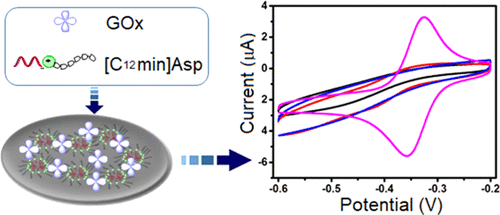当前位置:
X-MOL 学术
›
ACS Sustain. Chem. Eng.
›
论文详情
Our official English website, www.x-mol.net, welcomes your
feedback! (Note: you will need to create a separate account there.)
Amino Acid-Based Imidazole Ionic Liquid: A Novel Soft Matrix for Electrochemical Biosensing Applications
ACS Sustainable Chemistry & Engineering ( IF 7.1 ) Pub Date : 2021-03-02 , DOI: 10.1021/acssuschemeng.0c09419 Pei Yao 1, 2 , Shubai Li 2 , Alexander Lambert 3 , Quan Cheng 3 , Zhanjun Yang 1 , Xiashi Zhu 1, 4
ACS Sustainable Chemistry & Engineering ( IF 7.1 ) Pub Date : 2021-03-02 , DOI: 10.1021/acssuschemeng.0c09419 Pei Yao 1, 2 , Shubai Li 2 , Alexander Lambert 3 , Quan Cheng 3 , Zhanjun Yang 1 , Xiashi Zhu 1, 4
Affiliation

|
A new amino acid-based ionic liquid of 1-methyl-3-dodecane imidazolium aspartic acid ([Cnmim]Asp IL, n = 4, 6, 8, 12, 14) was reported as a soft matrix to be used as a novel electrochemical glucose biosensor. [Cnmim]Asp ILs were synthesized using a simple acid–base titration method and characterized by nuclear magnetic resonance spectroscopy, Fourier transform infrared (FT-IR) spectrum, scanning electron microscopy, negative-staining and cryogenic transmission electron microscopy, electrical conductivity, surface tension, dynamic light scattering, and UV–vis spectrum. [Cnmim]Asp ILs possessed excellent conductivity and a large specific surface area, providing a biocompatible microenvironment to promote enzyme-catalyzed direct electron transfer while maintaining surface bioactivity and stability. It was found that the micelle structure could form in the [C12mim]Asp IL solution when the concentration was beyond its critical micelle concentration. Glucose oxidase (GOx) could be uniformly dispersed and immobilized onto these micelles of the [C12mim]Asp IL soft matrix through a hydrogen bond and physical absorption. Electrochemical experiments demonstrated that [C12mim]Asp/GOx/Nafion/GCE achieved the best electrochemical performance toward glucose at a working potential of −0.33 V. The [C12mim]Asp-based enzyme sensor displays a linear range response to glucose concentration from 0.001 to 0.58 and 0.58 to 12 mM and a low-end detection limit of 0.572 μM (S/N = 3). Additionally, the present glucose biosensor is robust to interfering molecules and shows acceptable reproducibility and practical application for real samples. The proposed amino acid-based ionic liquid can serve as a versatile and promising soft immobilization matrix for development of excellent biosensor applications.
中文翻译:

氨基酸基咪唑离子液体:用于电化学生物传感应用的新型软基质
据报道,一种新的基于氨基酸的1-甲基-3-十二烷咪唑鎓天冬氨酸离子型离子液体([C n mim] Asp IL,n = 4、6、8、12、14 )被用作软基质。一种新型的电化学葡萄糖生物传感器。[C n mim] Asp ILs采用简单的酸碱滴定法合成,并具有核磁共振波谱,傅立叶变换红外(FT-IR)光谱,扫描电子显微镜,负染色和低温透射电子显微镜,电导率的特征。 ,表面张力,动态光散射和UV-vis光谱。[C nmim] Asp IL具有出色的电导率和较大的比表面积,提供了生物相容的微环境,可促进酶催化的直接电子转移,同时保持表面的生物活性和稳定性。发现当浓度超过其临界胶束浓度时,[C 12 mim] Asp IL溶液中可能形成胶束结构。葡萄糖氧化酶(GOx)可以通过氢键和物理吸收均匀分散并固定在[C 12 mim] Asp IL软基质的这些胶束上。电化学实验表明,[C 12 mim] Asp / GOx / Nafion / GCE在-0.33 V的工作电势下对葡萄糖具有最佳的电化学性能。[C 12基于mim] Asp的酶传感器对葡萄糖浓度的线性范围响应为0.001至0.58和0.58至12 mM,低端检测极限为0.572μM(S / N = 3)。另外,本发明的葡萄糖生物传感器对干扰分子具有鲁棒性,并显示出可接受的再现性和实际样品的实际应用。所提出的基于氨基酸的离子液体可作为通用的,有希望的软固定基质,用于开发出色的生物传感器应用。
更新日期:2021-03-22
中文翻译:

氨基酸基咪唑离子液体:用于电化学生物传感应用的新型软基质
据报道,一种新的基于氨基酸的1-甲基-3-十二烷咪唑鎓天冬氨酸离子型离子液体([C n mim] Asp IL,n = 4、6、8、12、14 )被用作软基质。一种新型的电化学葡萄糖生物传感器。[C n mim] Asp ILs采用简单的酸碱滴定法合成,并具有核磁共振波谱,傅立叶变换红外(FT-IR)光谱,扫描电子显微镜,负染色和低温透射电子显微镜,电导率的特征。 ,表面张力,动态光散射和UV-vis光谱。[C nmim] Asp IL具有出色的电导率和较大的比表面积,提供了生物相容的微环境,可促进酶催化的直接电子转移,同时保持表面的生物活性和稳定性。发现当浓度超过其临界胶束浓度时,[C 12 mim] Asp IL溶液中可能形成胶束结构。葡萄糖氧化酶(GOx)可以通过氢键和物理吸收均匀分散并固定在[C 12 mim] Asp IL软基质的这些胶束上。电化学实验表明,[C 12 mim] Asp / GOx / Nafion / GCE在-0.33 V的工作电势下对葡萄糖具有最佳的电化学性能。[C 12基于mim] Asp的酶传感器对葡萄糖浓度的线性范围响应为0.001至0.58和0.58至12 mM,低端检测极限为0.572μM(S / N = 3)。另外,本发明的葡萄糖生物传感器对干扰分子具有鲁棒性,并显示出可接受的再现性和实际样品的实际应用。所提出的基于氨基酸的离子液体可作为通用的,有希望的软固定基质,用于开发出色的生物传感器应用。











































 京公网安备 11010802027423号
京公网安备 11010802027423号